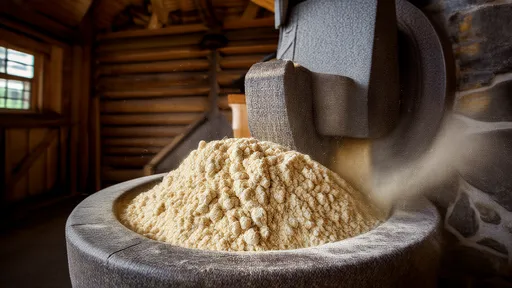The turbidity of fruit juice, often perceived as a mark of freshness and natural quality, is primarily governed by the suspension mechanisms of pulp particles. These tiny fragments of fruit flesh, ranging from cellular debris to larger fibrous clusters, create the characteristic cloudiness that consumers associate with premium products. Behind this seemingly simple phenomenon lies a complex interplay of physical forces, biochemical interactions, and processing variables that determine whether pulp remains evenly dispersed or separates over time.
At the microscopic level, the behavior of pulp particles defies common intuition about how solids behave in liquids. Unlike sand settling rapidly in water, fruit pulp can remain suspended for remarkably long periods due to several factors. The density difference between pulp and the liquid phase plays a crucial role, with many fruit cells having a specific gravity only slightly higher than the surrounding juice. This near-neutral buoyancy means minor disturbances can keep particles aloft. Moreover, the irregular shapes of plant cells create fluid drag disproportionate to their mass, slowing their descent according to modified versions of Stokes' law that account for non-spherical geometries.
The surface chemistry of pulp particles introduces another layer of complexity. Plant cell walls carry negative charges from pectin molecules and other polysaccharides, creating mutual repulsion that prevents aggregation. This electrostatic stabilization resembles the mechanism keeping clay particles suspended in river deltas for geological timescales. However, in juice systems, the ionic strength from naturally occurring minerals can compress this electrical double layer, potentially leading to flocculation. Citrus juices particularly demonstrate this delicate balance, where calcium ions from the fruit can either stabilize or destabilize the suspension depending on concentration.
Pectin, the structural carbohydrate in plant cell walls, serves dual functions in juice turbidity. While fragments contribute to the suspended solids, dissolved pectin molecules increase the continuous phase's viscosity. This elevated viscosity slows particle sedimentation exponentially - a relationship described by the Mason-Weaver equation. Thermal processing during juice production partially hydrolyzes pectin, explaining why pasteurized juices often show faster clarification than fresh-pressed equivalents unless processors add back commercial pectin as a stabilizer.
The particle size distribution of pulp creates a self-stabilizing effect through polydispersity. Larger particles sediment first, creating microcurrents that sweep smaller particles upward in a process called "hindered settling." This phenomenon explains why single-strength orange juice maintains uniform cloudiness better than concentrates diluted prior to consumption. Industrial homogenization, while reducing average particle size, can ironically accelerate clarification by eliminating the critical large particles that drive this beneficial turbulence.
Temperature fluctuations in storage and transport dynamically affect juice cloud stability. Warmer temperatures decrease liquid viscosity, speeding sedimentation, while also increasing Brownian motion that fights gravitational settling. This counterintuitive balance means tropical fruit juices might show better stability at 4°C than at 25°C, while temperate fruit juices behave oppositely. The thermal expansion coefficients of juice components add another variable, as density gradients form during temperature changes, sometimes creating convection cells that remix settled pulp.
Modern juice processors employ various technologies to control turbidity without artificial additives. Ultrasonic treatment can reduce particle size while preserving fresh flavor notes, creating stable suspensions that resist clarification for months. Membrane filtration techniques allow precise adjustment of pulp content, with ceramic membranes capturing specific particle size ranges to achieve desired mouthfeel and visual appeal. Some manufacturers utilize controlled enzymatic treatment to modify pectin structure, creating a natural stabilizer from the fruit's own components.
Consumer psychology surrounding juice turbidity reveals fascinating cultural dimensions. Western markets traditionally associated clarity with purity, driving the popularity of filtered apple and grape juices. However, marketing campaigns successfully shifted perceptions toward cloudy juices as containing more nutrients and authentic fruit character. In Asian markets, particulate-loaded beverages have long been preferred, leading to formulations with intentionally enhanced pulp content. This cultural lens affects product development, as food scientists balance physical stability with regional expectations about what constitutes "natural" appearance.
Emerging research suggests juice turbidity may influence flavor perception beyond visual cues. The slow release of aromatic compounds from suspended pulp particles could create a more prolonged flavor experience compared to clear juices. This phenomenon, studied using techniques like proton-transfer-reaction mass spectrometry, shows how cloudiness might enhance the temporal dimension of taste. Such findings are driving innovation in premium juice products where mouthfeel and flavor persistence command price premiums.
The future of juice turbidity control lies in precision food engineering. Advances in computational fluid dynamics allow modeling of suspension behavior under various conditions, reducing trial-and-error in product development. Nanotechnology applications might yield invisible stabilizers that maintain cloudiness without altering mouthfeel. As consumers continue to equate visual cues with quality and naturalness, understanding and controlling pulp suspension mechanisms will remain crucial for juice manufacturers worldwide.
The art of baking a perfect cake relies heavily on understanding the science behind its structure. Among the many factors that contribute to a cake's texture, the uniformity of air pockets within the cake crumb stands out as a critical element. This characteristic is largely influenced by the foaming properties of proteins in the batter, particularly those found in eggs. The way proteins trap and stabilize air bubbles during mixing directly impacts the final product's lightness, tenderness, and overall mouthfeel.
The world of sensory evaluation is as intricate as it is fascinating, particularly when it comes to understanding how we perceive flavors and aromas. Among the myriad of compounds that contribute to our sensory experiences, vanillin—the primary component of vanilla extract—stands out for its widespread use and complex interaction with our senses. The concept of odor threshold plays a pivotal role in determining how much of this compound is needed for it to be detectable, and it varies significantly depending on the medium in which it is presented.
The world of chili peppers is as diverse as it is fiery, with each variety packing its own unique punch. At the heart of understanding this heat lies the Scoville Scale, a measurement that quantifies the spiciness of peppers. Developed by Wilbur Scoville in 1912, this scale remains the gold standard for gauging the capsaicin content—the compound responsible for that burning sensation—in different peppers. From the mild bell pepper to the mind-numbing Carolina Reaper, the Scoville Scale offers a fascinating glimpse into the spectrum of heat that chili enthusiasts chase.
The culinary world has long celebrated the magic that happens when certain ingredients come together, creating flavors greater than the sum of their parts. One such pairing—chicken broth and mushrooms—exemplifies the scientific and gastronomic phenomenon known as umami synergy. This dynamic duo has been a staple in kitchens across cultures, from French consommé to Japanese ramen, and its power lies in the way their compounds interact to amplify savory depth.
The world of fermented foods is a fascinating intersection of microbiology, chemistry, and culinary tradition. Among these, kimchi stands out not only for its bold flavors but also for the intricate biochemical processes that transform raw vegetables into a probiotic-rich delicacy. At the heart of this transformation lies a phenomenon known as acetic acid penetration, which creates a dynamic pH gradient during fermentation. This process is far more than a simple souring of cabbage—it's a carefully orchestrated dance between microbial communities and their chemical environment.
The turbidity of fruit juice, often perceived as a mark of freshness and natural quality, is primarily governed by the suspension mechanisms of pulp particles. These tiny fragments of fruit flesh, ranging from cellular debris to larger fibrous clusters, create the characteristic cloudiness that consumers associate with premium products. Behind this seemingly simple phenomenon lies a complex interplay of physical forces, biochemical interactions, and processing variables that determine whether pulp remains evenly dispersed or separates over time.
The fizz in your soda isn't just about taste—it's a carefully engineered dance between gas and liquid that begins unraveling the moment you twist open the cap. Few consumers realize how precisely carbonation levels are calibrated, or how dramatically pressure dynamics shift during that first explosive release. This invisible physics experiment in every bottle follows predictable but fascinating patterns that beverage scientists have spent decades mapping.
The world of espresso is as complex as it is captivating, with its rich flavors and aromatic allure. At the heart of this complexity lies a seemingly simple yet scientifically intricate component: the crema. This golden-brown layer of foam that crowns a well-pulled shot of espresso is not just a visual delight but a fascinating study in colloidal stability. The interplay of oils, gases, and solids in espresso crema reveals a delicate balance that defines the quality and texture of the coffee.
The phenomenon of "cold turbidity" or "cream down" in tea has long intrigued both tea connoisseurs and scientists alike. This natural occurrence, where tea liquor turns cloudy upon cooling, is not merely an aesthetic curiosity but a window into the complex chemistry of tea. Recent advancements in optical measurement techniques have enabled researchers to quantify this phenomenon through turbidity detection based on tea liquor transmittance, opening new avenues for quality assessment and understanding of tea's molecular interactions.
The world of instant noodles thrives on convenience, but behind that simplicity lies a carefully engineered marvel of food science. At the heart of this innovation sits pregelatinized starch—an unsung hero that transforms dehydrated noodles into a steaming bowl of comfort within minutes. Unlike traditional starch, pregelatinized starch undergoes a thermal and mechanical treatment that breaks down its granular structure, allowing it to absorb water rapidly. This property is pivotal for instant noodles, where rehydration speed and texture determine consumer satisfaction.
The world of traditional fermented foods holds countless microbial secrets, and few are as fascinating as the complex ecosystem of laomian – the centuries-old sourdough starter that gives Chinese steamed bread its distinctive character. While modern bakeries increasingly rely on commercial yeast, artisanal producers across northern China still maintain their family laomian cultures like precious heirlooms, passing down not just techniques but living microbial communities through generations.
The sticky, chewy texture of glutinous rice cakes, known as mochi in Japanese or nuòmǐ cí in Chinese, has long been a staple in East Asian cuisine. These delectable treats, often enjoyed during festivals or as everyday snacks, owe their unique consistency to a key component: amylopectin, the branched-chain starch found in glutinous rice. However, anyone who has left mochi or Chinese mochi cakes (糍粑) at room temperature for a few hours will notice an unmistakable transformation—the once-soft and pliable dessert gradually hardens, becoming tougher and less enjoyable. This phenomenon, often referred to as retrogradation, is a fascinating interplay of chemistry, physics, and culinary science.
The art of cooking perfect rice lies in understanding the gelatinization temperature of different japonica rice varieties. This scientific parameter, often overlooked by home cooks, determines the precise moment when starch granules absorb water and swell—fundamentally shaping texture, flavor release, and nutritional accessibility. Recent studies across Asian research institutions reveal how subtle genetic variations in short-grain rice cultivars create distinct thermal behaviors during cooking, challenging the one-size-fits-all approach to water ratios and heat application.
The art of crafting perfect hand-pulled noodles lies in mastering the delicate balance between gluten development and dough relaxation. Among the many variables that influence noodle extensibility, resting time stands as one of the most critical yet often overlooked factors. This silent alchemy occurring during the waiting period transforms a stiff, unyielding mass into an elastic, cooperative material ready to be stretched into silky strands.
For generations, home cooks and professional chefs alike have relied on stainless steel containers for pickling and food storage. The material's reputation for durability and corrosion resistance makes it a seemingly ideal choice. But when acidic ingredients like vinegar enter the equation, questions arise about potential metal leaching and food safety. Understanding the interaction between stainless steel and pickling brines requires a deeper dive into metallurgy, chemistry, and culinary science.
The bamboo steamer, a centuries-old culinary tool cherished across Asian kitchens, operates on principles far more sophisticated than its simple appearance suggests. Among its most fascinating phenomena is the so-called "bamboo steamer effect" – a self-regulating mechanism that prevents the dreaded condensation drip-back, ensuring perfectly textured dumplings, buns, and fish every time. This natural engineering marvel has captivated chefs and scientists alike, revealing how traditional wisdom often anticipates modern food science.
The age-old practice of stone milling has long been revered for its ability to produce flour that retains the natural goodness of whole grains. Unlike modern industrial milling methods, which often prioritize speed and shelf life, stone grinding operates at a slower pace, preserving the integrity of the grain’s nutritional profile. One of the most significant advantages of this traditional method is its ability to maintain higher levels of dietary fiber in whole wheat flour—a component essential for digestive health, blood sugar regulation, and overall well-being.
















